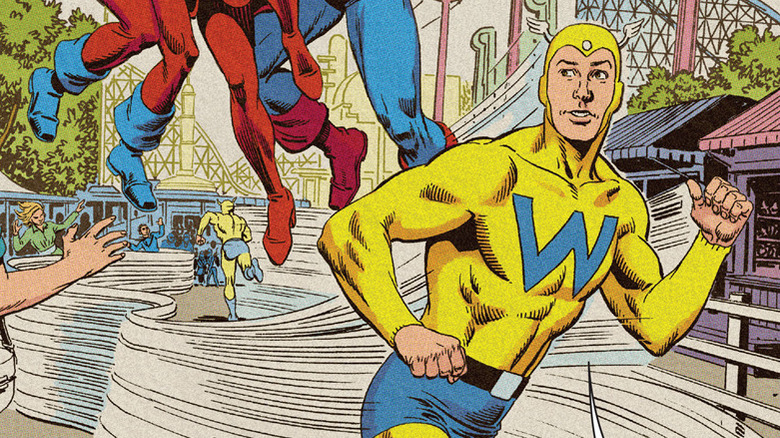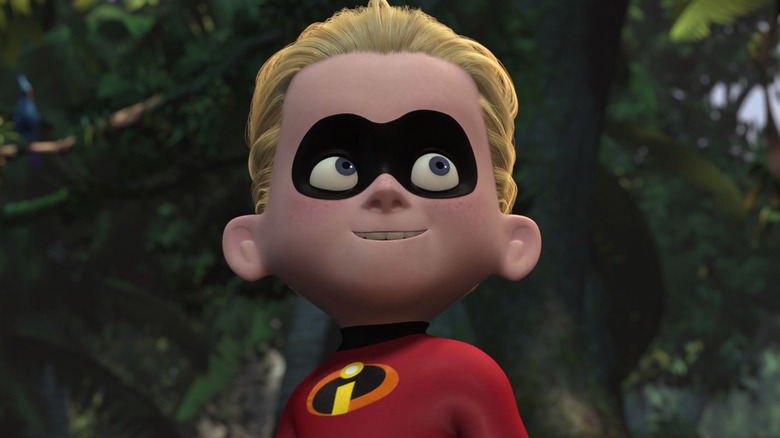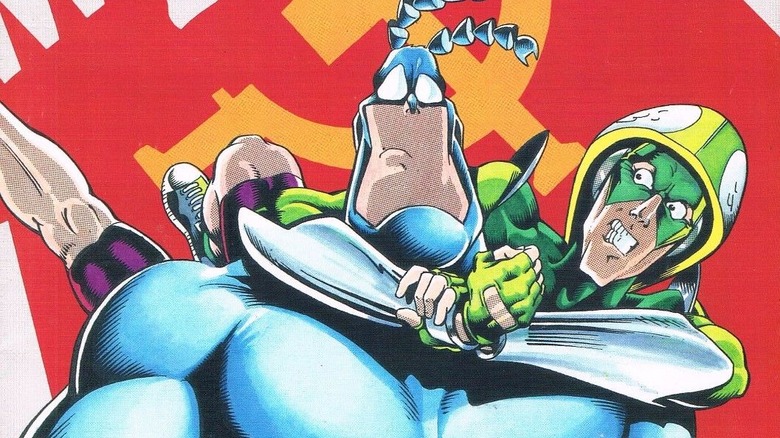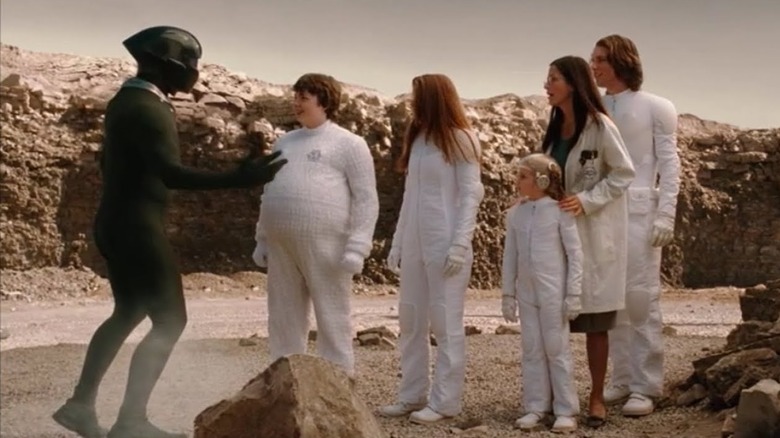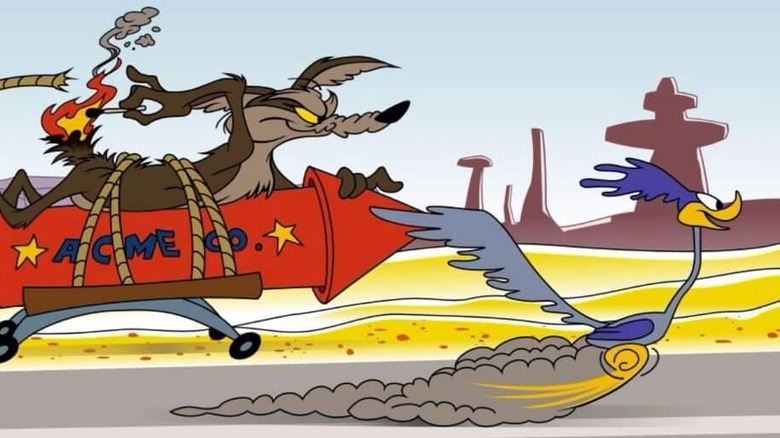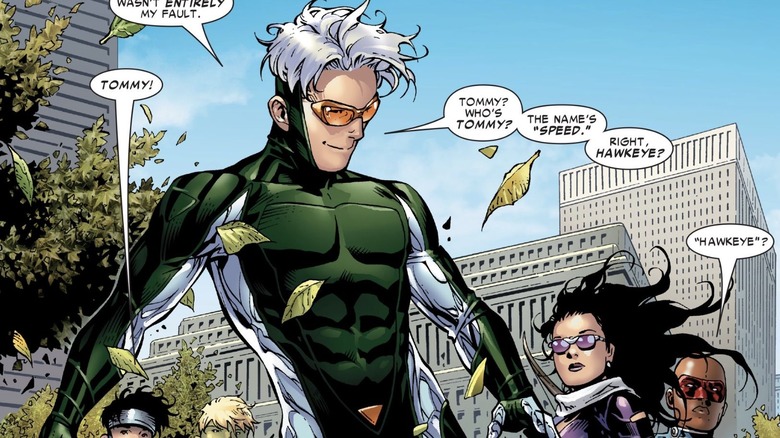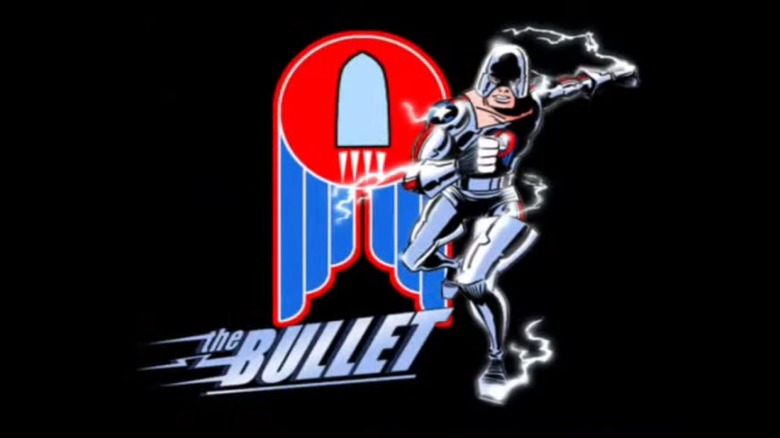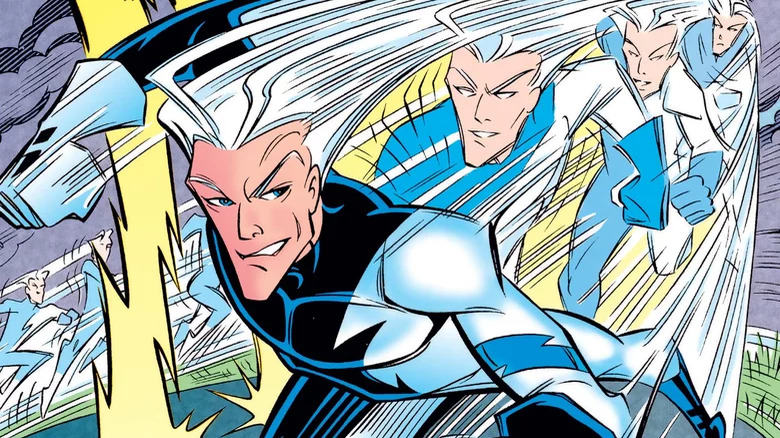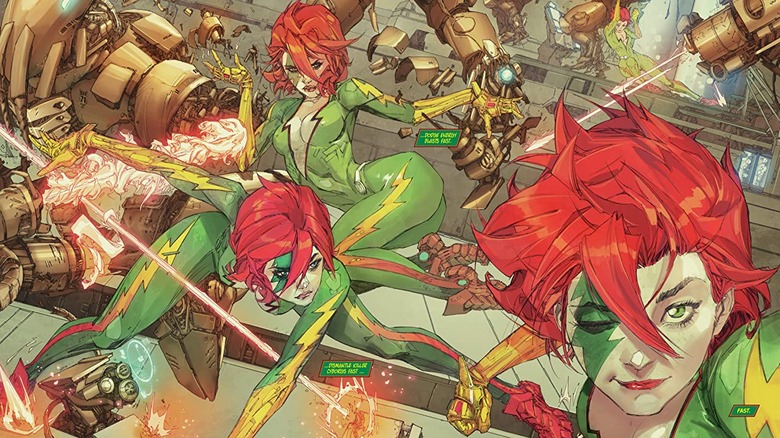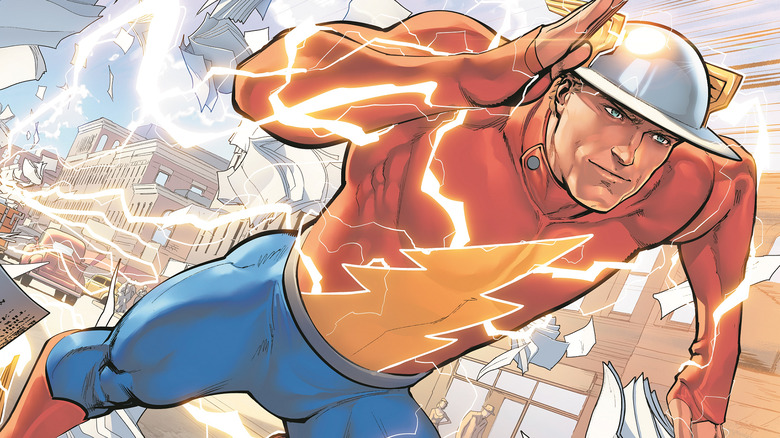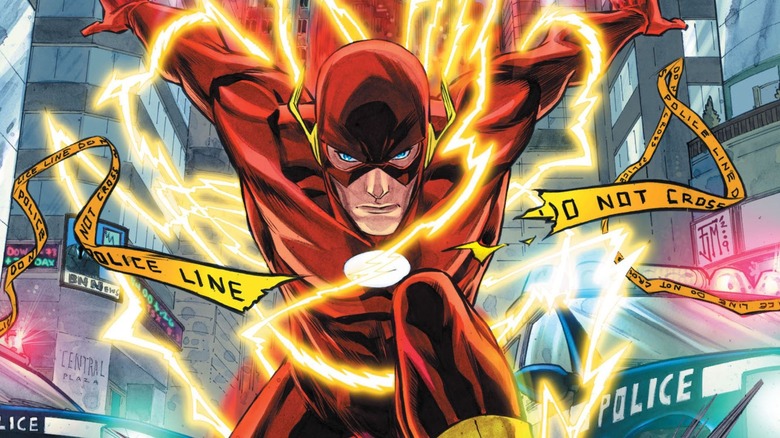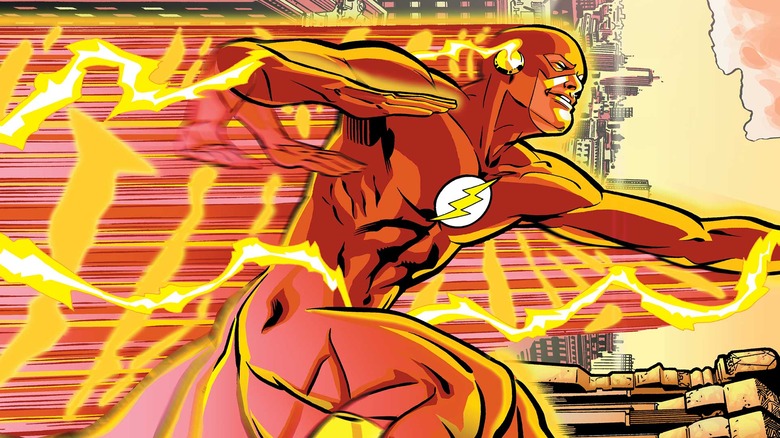Fastest Speedsters In History Ranked
When Jay Garrick ran onto the comic book page in 1940's "Flash Comics" #1, a new type of hero was born. Before this, superheroes either didn't have powers at all (like Batman) or had a plethora of fantastic abilities (like Superman), but with the genesis of the Flash, a new, single-powered hero had arrived on the scene. All of his fantastic feats would be derived from one thing: creative applications of his super-speed.
With that, the "speedster," as we now understand it, was born. This term doesn't include any character with superhuman speed, but rather focuses on those who must rely on that speed alone, typically without any other locomotive abilities like flight or long-distance jumping. Thus, while Marvel's Quicksilver and Sonic the Hedgehog meet this criteria, Superman and the Silver Surfer do not. The speedster has become an archetype across many franchises, but they aren't all created equal — with that in mind, here are some of the most famous examples, ranked by the one thing that unites them all: speed.
14. The Whizzer
At the bottom of the list sits Marvel Comics' "The Whizzer." Yes, that is his name — and yes, his costume is bright yellow, but he was created in 1941's "U.S.A. Comics" #1, and it was a different time. Created by Al Avison, Robert Frank was granted the ability to move at speeds up to 100 mph (~160 kph) after his father injected him with mongoose blood in order to save him from a cobra bite.
While it's not quite clear why this worked, it's also not unlikely that Bob was a mutant whose powers were triggered by the trauma of the event rather than the, you know, mongoose blood. With a max speed that can be outpaced by many automobiles, the Whizzer is easily the slowest person on this list — though his status as one of Marvel's first speedsters does earn him a fair amount of cred.
13. Dash
"The Incredibles" took the world by storm in 2004, quickly becoming one of Pixar's most beloved films. Clearly modeled after Marvel's Fantastic Four, Brad Bird's film family featured superheroes who all demonstrated a different super-power. Mr. Incredible had super strength, Elastigirl could stretch, their daughter Violet could turn invisible, and their son, Dash, could run at fantastic speeds.
It's not quite clear how fast Dash can run, however. During the films, he is fast enough to run on water and up buildings, but a definitive speed is never given. The video game tie-in that was released alongside the film in 2004 gave Dash a max speed of 190 mph (305 kph), but it's not clear if this is "canon" for the films or not. One user on Reddit calculated that Dash would have needed to run at least 230 mph (370 kph) in order to place the pin on his teacher's desk at the beginning of the first film without showing up on the low-quality security camera, but even that feat was likely nowhere near what Dash may be capable of, especially as he gets older and longer legs enhance his stride.
12. The Running Guy
Next up is one of the most obscure characters on this list: "The Running Guy" from "The Tick" franchise, brought to live action fruition most recently for a second time on Amazon Prime Video in 2016. Introduced in "The Tick" #6 in 1989, the Running Guy is the series parody of DC's The Flash, but unlike his famed counterpart, the Running Guy can reach speeds that make him "faster than ten fast men." Now, this is by no means a specific number, but it does provide a decent range.
Usain Bolt set the human land speed record at 27 mph (43 kph), while the more common average top speed of human beings rests somewhere around 15 mph (24 kph). With these numbers, if The Running Guy is literally "faster than ten fast men," his top speeds would range slightly above roughly 150 to 270 mph (240 to 430 kph). That's not bad, but he'd still finish this foot race nowhere near first place.
11. Zoom
Tim Allen's 2006 film "Zoom" was a box office bomb and a critical failure, but it still gave the world one more speedster. At the beginning of the film, Jack Shepard's days as "Captain Zoom" are over, and his super-speed is good for little more than making the man a human smoothie blender. Despite this, he's called back into action to train a new generation of heroes, but when those same children are in danger in the film's climax, Jack's powers return and he is "Captain Zoom" once again.
Though there's no way of knowing how fast Shepard was in his prime, and a definite measurement is never provided, audiences see the present day version of Jack perform a number of common speedster feats. He runs at superspeed across a flat desert landscape, easily dodges energy blasts from the film's villain, and runs in circles fast enough to generate a tornado that somehow manages to also close a fairly generic portal.
The fastest tornado wind-speed ever recorded was 302 mph (486 kph). Since Jack's tornado had to withstand multiple energy blasts without dissipating, it seems safe to figure that his was going at least this speed, and since Jack would need to be moving faster than this in order to create the tornado, he was likely traveling around 300 to 400 mph (644 kph). But, coupled with his tendency to trip, Captain Zoom's speed won't be earning him any medals any time soon.
10. The Road Runner
The Looney Toons franchise contains some of the most beloved cartoon characters of all time — and one of them. the Road Runner, is famous for leaving his prime predator Wile E. Coyote in the dust. Like other characters on this list, the Road Runner's speed is never explicitly confirmed, but one fan used the standard width of United States interstates to attempt to calculate how fast the bird ran in his first appearance ever.
1949's "Fast and the Furry-ous" was the first pairing of this iconic couple. Finding himself quite hungry, Wile E. Coyotes decides he's going to catch a running bird for dinner, but no matter how many intricate, crazy schemes he comes up with, he is always doomed to fail. During one of these attempts, the running bird races around a circular road at a calculated speed of roughly 402 mph (648 kph).
Later in the episode, the coyote attempts to catch the bird on a straightaway using a rocket, briefly managing to catch up to the bird at a calculated speed of about 682 mph (1,098 kph). With these speeds in mind, fans can see that the Road Runner sprints at very nearly the speed of sound, but he's just under sub-sonic.
9. Speed
Introduced in "Young Avengers" #10, Thomas Shepherd is one of Marvel's newest speedsters, and many fans may not realize that they've already met him in Disney+'s "WandaVision." Played by Jett Klyne in the series, Tommy is one of the twin children that Wanda Maximoff (aka the Scarlet Witch) creates using her reality-altering magic powers. This is roughly how Tommy and his twin brother Billy come to exist in the comics as well, though their existence is permanent.
Like his uncle before him, Tommy has super-speed and white hair, and when he joined his brother on the Young Avengers team, he took on the codename "Speed." It's one syllable. It's descriptive. It works. But just how fast is Speed?
According to Tommy himself in 2021's "X-Factor" #7, the boy's record is 761 mph (1,225 kph). This is just under the speed of sound, making Speed the last sub-sonic entry on this list. Like most comics, however, Speed's actual limits are unknown, but his character follows the general rule that he's slightly slower than his Uncle Pietro.
8. The Bullet
Perhaps tied for the most obscure character on this list, the Bullet is one of the heroic members of the Freedom Force. Introduced in the video game series of the same name, the Bullet was an ace military test pilot during the Vietnam War named Dwight Arrow, who was shot down behind enemy lines by a mysterious beam of energy.
After landing, Arrow discovered that the strange energy had given him superpowers, as he successfully attempted to dodge a hail of bullets fired by Vietnamese soldiers. During his escape, Dwight took down a helicopter by generating a mini-tornado, outran Vietnamese fighter jets and their bullets, and returned to the United States by running across the Pacific Ocean.
In the real world, bullets typically travel at least as fast Mach 2, or two times the speed of sound. Since the Bullet was outrunning the round fired at him, this makes him the first super-sonic racer on this list.
7. Quicksilver
Coming in surprisingly far behind the head of the pack is none other than Marvel Comics' premiere speedster, Pietro Maximoff, also known as Quicksilver. Though his origin has shifted over the years, he and his twin sister Wanda are traditionally the twin children of the mutant supervillain known as Magneto. Together, they were all founding members of the Brotherhood of Evil Mutants before Wanda and Pietro left their father to join the Avengers.
During the early years of his publication history, Pietro's max speed was said to be around 175 mph (281 kph). If he had stayed at this speed, he would have been several spots higher, but after he was exposed to "Isotope E" by the High Evolutionary, his speed increased dramatically.
Suddenly hypersonic, Quicksilver could now easily run up to five times the speed of sound. His current record rests around Mach 10, though its believed that he still hasn't discovered his upper limits. Though this is still nowhere near how fast he runs in "X-Men: Days of Future Past," it's certainly nothing to scoff at.
6. Velocity
Introduced by Marc Sivestri in 1992's "Cyberforce" #1, Velocity is the resident super-heroic speedster of two of Marvel and DC's competitors: Image Comics and Top Cow Productions. Often serving as the series' point of view character, Velocity was originally a teenage girl named Carin Taylor before a company named Cyberdata experimented on Carin and gave her superhuman speed via cybernetic augmentation.
The upper, extreme limits of her super speed are unknown, but unlike others on this list, that is on purpose. Afraid that going too fast could disrupt or destroy the planet, Velocity refuses to go much faster than 10,000 mph (16,000 kph). That's 13 times the speed of sound, though she usually tends to stay around Mach 3 under normal circumstances. In theory, Velocity might be capable of speeding much higher up the list, but since she refuses to find out, this is where she ultimately winds up.
5. Sonic the Hedgehog
One of the most prolific video game characters of all time, Sonic the Hedgehog has, in many ways, become a franchise unto himself. He was introduced by Sega in his first video game in 1991, and has since gone on to appear in numerous other games, several television series, a long-running comic book series, and most recently, a live-action movie released in 2020 starring Jim Carrey (a sequel is on the way where Carrey will return as Doctor Eggman).
That much media makes Sonic a massive hit, sure, but it also makes his actual speed extremely difficult to determine. Which version of sonic reigns supreme, and what sources should fans accept as canon? Additionally, should fans count the various upgrades or power-ups he's received over the years like his "Light Speed Shoes," or his golden Super Sonic form?
If Sonic is taken at his base, non-upgraded form, a general range can somewhat be determined. Given his name, it's generally accepted that he can at least reach the speed of sound at 767 mph (1,234 kph). Though many games don't specify how fast he might be going, several place his speed at around Mach 3 or 4, while the "Sonic the Hedgehog" comic book series clocks his ultimate speed record at Mach 15. If all of these numbers are accepted as a range, then Sonic firmly earns his spot in fifth place.
4. Jay Garrick (the original Flash)
Jay Garrick, the original Flash, is the one that started it all. Introduced in January of 1940, Jay is one of the original Golden Age superheroes. In fact, his existence predates so many speedster tropes that fans have come to know and love that he didn't even run on water when receiving his first off-the-coast mission in 1940's "Flash Comics" #4 — he swam. That's right, the trope hadn't been conceived yet, so he simply swam from the ship back and forth faster than any speed boat could hope to match.
Eventually, however, the character grew and evolved, spawning an entire family of successors bearing the name and emblem of the Flash. Comics like 1990's "Flash Special" #1 attempted to differentiate Jay's super-speed abilities from the others by saying he could accelerate faster than this peers, but that he couldn't maintain his top speed, the speed of light, for anywhere near as long as they could. As Jay aged and got older, this became more and more true, and though he can still just about reach the speed of light, it takes almost everything he has.
Jay is far beyond super-sonic, but he's usually still just barely sub-light.
3. Hammy
A normal red squirrel can typically sprint at about 14 mph (22.5 kph), but Hammy from the 2006 film "Over the Hedge" is on an entirely different level. Presented as quick, inattentive, and extraordinarily hyperactive on a normal day, the film's cast of animal characters make a desperate decision in the film's climax: they give Hammy a "Mach 6 Energy Drink: Now with More Caffeine." In one of the most memorable scenes from the movie, Hammy effortlessly reaches the speed of light at a slow walk, activating a pest control trap that saves the group from the story's villains.
To say that this feat is extreme is an understatement. With just a single energy drink, Hammy is easily able to reach speeds that the Flash struggles to achieve on a good day, and he does it at a slow walk. Heaven help the world should he decide to run. Exciting as that thought is, Hammy's reliance on the caffeine, combined with the relatively short amount of time it lasts, both keep him in third place.
2. Barry Allen (the second Flash)
By the time Barry Allen was introduced as the second Flash in 1956's "Showcase" #4, superhero comics had all but died out in favor of other genres including mysteries, romances, and war stories — but after the Scarlet Speedster sped into readers' imaginations, that would never be the case again. The success of the Flash prompted DC Comics to both relaunch the character's solo series, and revamp other old heroes like Green Lantern.
Eventually, these heroes' successes encouraged DC to form the superhero team known as the Justice League, and that series' wild popularity prompted Martin Goodman (the chief editor of Timely Comics) to order Stan Lee to create his own team of heroes. Lee obliged and, together with Jack Kirby, they created the Fantastic Four and essentially started Marvel Comics as we know it today.
All of that is thanks to the success of Allen, but despite his grand importance in comic book history, he is not the fastest person on this list. As the Flash, his top speed is commonly at least the speed of light, though he has often exceeded that limit in particularly dire circumstances. Ultimately, however, Barry Allen's speed became second-to-one after he was surpassed by his favorite student.
1. Wally West (the third Flash)
His name is Wally West. He is the Flash, the Fastest Man Alive. Raised in the middle of nowhere, Wally West became Barry's sidekick, Kid Flash, after the same freak accident that turned Allen into the second Flash happened again. Lightning struck twice, and when Barry Allen died saving the universe in 1986's "Crisis on Infinite Earths," Wally vowed to continue his uncle's legacy and become the third Flash.
At the time, however, his speed was stunted at a mere 767 mph (1234 kph), the speed of sound. Over time, however, Wally overcame the mental blocks that were holding him back, and once he finally let go of his fear of overshadowing Barry's memory, he reached his full potential and ran far faster than Barry had ever dreamed of.
There are numerous feats from Wally's decades-long tenure as the Flash that demonstrate this. In 2001's "The Flash" #177, he outraces the light trapped in the gravitational pull of a black hole. In 1998's "The Flash" #138, "The Human Race," Wally steals the velocity of every living person on planet earth in order to travel across the galaxy faster than instantaneous teleportation, without the use of time travel. And in 1997's "JLA" #89, the Flash evacuates the entire, half-million population of Chonjin, North Korea in one-thousandth of a microsecond, a feat that forced him to travel 13 trillion times the speed of light. Wally is the fastest speedster in history, and it isn't even a contest.

